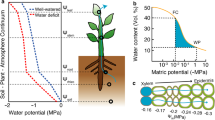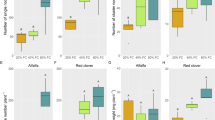Abstract
Responses to soil flooding and oxygen shortage were studied in field, glasshouse and controlled environment conditions. Established stools ofSalix viminalis L., were compared at five field sites in close proximity but with contrasting water table levels and flooding intensities during the preceding winter. There was no marked effect of site on shoot extension rate, time to half maximum length or final length attained. When rooted cuttings were waterlogged for 4 weeks in a glasshouse, soil redox potentials quickly decreased to below zero. Shoot extension was slowed after a delay of 20 d, while, in the upper 100 mm of soil, formation and outgrowth of unbranched adventitious roots with enhanced aerenchyma development was promoted after 7 d. At depths of 100–200 mm and 200–300 mm, extension by existing root axes was halted by soil flooding, while adventitious roots from above failed to penetrate these deeper zones. After 4 weeks waterlogging, all arrested root tips recommenced elongation when the soil was drained; their extension rates exceeding those of roots that were well-drained throughout. Growth in fresh mass was also stimulated. The additional aerenchyma found in adventitious roots in the upper 100 mm of soil may have been ethylene regulated since gas space development was inhibited by silver nitrate, an ethylene action inhibitor. The effectiveness of aerenchyma was tested by blocking the entry of atmospheric oxygen into plants with lanolin applied to lenticels of woody shoots of plants grown in solution culture. Root extension was halved, while shoot growth remained unaffected. H Lambers Section editor
Similar content being viewed by others
References
Armstrong W 1968 Oxygen diffusion from the roots of woody species. Physiol. Plant. 21, 539–543.
Armstrong W, Brändle R and Jackson M B 1994 Mechanisms of flooding resistance in plants. Acta Bot. Neerl, 43, 307–358.
Barber D A and Lee R B 1974 The effect of micro-organisms on the absorption of manganese by plants. New Phytol. 73, 97–101.
Beyer EJr 1976 Silver ion: a potent antiethylene agent in cucumber and tomato. HortSci. 11, 195–196.
Blom C W P M, Voesenek L A C J, Banga M, Engelaar W M H G, Rijnders J H G M, Van DeSteeg H M and Visser E J W 1994 Physio logical ecology of river species: adaptive responses of plants to submergence. Ann. Bot. 74, 253–263.
Bohm H L 1971 Redox potentials. Soil Sci. 112, 39–45.
Brailsford R W, Voesenek L A C J, Blom C W P M, Smith A R, Hall M A and Jackson M B 1993 Ethylene production by primary roots ofZea mays L. in response to sub-ambient partial pressures of oxygen. Plant Cell Environ. 16, 1071–1080.
Christy P, Newman E I and Campbell R 1978 The influence of neighbouring grassland plants on each others endomycorrhizae and root surface micro-organisms. Soil Biol. Biochem. 10, 521–527.
Crawford R M M 1992 Oxygen availability as an ecological limit to plant distribution. Adv. Ecol. Res. 23, 93–185.
Crawford R M M and Brändle R 1996 Oxygen deprivation in a changing environment. J. Exp. Bot. 47, 145–160.
Coutts M P and Philipson J J 1978 Tolerance of tree roots to waterlogging. I. Survival of Sitka spruce and Lodgepole pine to waterlogged soil. New Phytol. 80, 63–69.
Drew M C and Saker L R 1986 Ion transport to the xylem in aerenchymatous roots ofZea mays L. J. Exp. Bot. 37, 22–33.
Drew M C, Cobb B G, Johnson J R, Andrews D, Morgan P W, Jordan W and He C J 1994 Metabolic acclimation of root tips to oxygen deficiency. Ann. Bot. 74, 281–286.
Etherington J R 1984 Comparative studies of plant growth and distribution in relation to waterlogging X. Differential formation of adventitious roots and their experimental excision inEpilobium hirsutum andChamerion angustifolium. J. Ecol. 72, 389–404.
Gill C J 1975 The ecological response of adventitious rooting as a response to flooding in woody species with special reference toAlnus glutinosa (L.) Gaertn. Flora 164, 85–97.
Good J E G, Winder J D, Sellers E and Williamson T G 1992 Species and clonal variation in growth responses to waterlogging and submersion in the genusSalix. Proc. Roy. Soc. Edinb. 98B, 21–48.
Grable A R 1971 Soil aeration and plant growth. Adv. Agron. 18, 57–106.
Hall K C 1978 A gas chromatographic method for determination of oxygen dissolved in water using an electron capture detector. J. Chromatogr. Sci. 16, 311–316.
Jackson M B 1985 Ethylene and the responses of plants to excess water in their environment.In Ethylene and Plant Development. Eds. J ARoberts and G ATucker. pp 241–265. Butterworths, London, UK.
Jackson M B 1990 Hormones and developmental change in plants subjected to submergence or soil waterlogging. Aquat. Bot. 39, 49–72.
Jackson M B 1993 Are plant hormones involved in root to shoot communication? Adv. Bot. Res. 19, 103–187.
Joly C A 1991 Flooding tolerance in tropical trees.In Plant Life Under Oxygen Deprivation. Ecology, Physiology and Biochemistry. Eds. M BJackson, D DDavies and HLambers. pp 23–34. SPB Academic, The Hague, the Netherlands.
Kawase M 1972 Submersion increases ethylene and stimulates rooting in cuttings. Proc. Int. Plant Prop. Soc. 22, 360–367.
Kozlowski T T 1984 Responses of woody plants to flooding.In Flooding and Plant Growth. Ed. T TKozlowski. pp 129–163. Academic Press, New York, USA.
Krasny M E, Zasada J C and Vogt K A 1988 Adventitious rooting of four Salicaceae species in response to a flooding event. Can. J. Bot. 66, 145–151.
Menegus F, Cattaruzza L, Scaglioni L and Ragg E 1992 Effects of oxygen levels on metabolism and development of seedlings ofTrapa natans and two ecologically related species. Physiol. Plant. 85, 168–177.
Reid D M and Crozier A 1971 Effects of waterlogging on the gibberellin content and growth of tomato plants. J. Exp. Bot. 22, 39–48.
Rowe R N and Beardsell D V 1973 Waterlogging of fruit trees. Hort. Abstr. 43, 533–548.
Setter T L and Ella E S 1994 Relationship between coleoptile elongation and alcoholic fermentation in rice exposed to anoxia 1. Importance of treatment conditions and different tissues. Ann. Bot. 74, 265–271.
Smit B A, Neuman D S and Stachowiak M L 1990 Root hypoxia reduces leaf growth. Role of factors in the transpiration stream. Plant Physiol. 92, 1021–1028.
Summers J E and Jackson M B 1993 Anaerobic conditions strongly promote extension by stems of overwintering tubers ofPotamogeton pectinatus L. J. Exp. Bot. 45, 1309–1318.
Talbot R J and Etherington J R 1987 Comparative studies of plant growth in relation to waterlogging XIII. The effects of Fe2+ on photosynthesis and respiration ofSalix caprea andS. cinerea ssp.oleifolia. New Phytol. 105, 575–583.
Talbot R J, Etherington J R and Bryant J A 1987 Comparative studies of plant growth distribution in relation to waterlogging XII. Growth, photosynthetic capacity, metal ion uptake:Salix caprea, S. cinerea. New Phytol. 105, 563–574.
Topa M A and McLeod K W 1988 Promotion of aerenchyma formation inPinus serotina seedlings, by ethylene. Can. J. For. Sci. 18, 276–280.
Vartapetian B B, Andreeva I N and Nuritdinov N 1978 Plant cells under oxygen stress.In Plant Life in Anaerobic Environments. Eds. D DHook and R M MCrawford. pp 13–88. Ann Arbor Science, Ann Arbor.
Wiedenroth E-M and Jackson M B 1993 Depletion of oxygen in roots following encasement in olive oil. Ann. Bot. 71, 427–430.
Wilkinson J 1944 Some factors affecting the distribution of theCaprea group ofSalix in the Gower. J. Ecol. 32, 214–221.
Wilson J B 1988 A review of evidence on the controls of root:shoot ratios, in relation to models. Ann. Bot. 61, 433–449.
Yamamoto F, Kozlowski T T and Wolter K E 1987 Effects of flooding on growth, stem anatomy and ethylene production ofPinus halepensis seedlings. Can. J. For. Res. 17, 69–79.
Zimmermann P W 1930 Oxygen requirements for root growth of cuttings in water. Am. J. Bot. 17, 842–861.
Author information
Authors and Affiliations
Rights and permissions
About this article
Cite this article
Jackson, M.B., Attwood, P.A. Roots of willow (Salix viminalis L.) show marked tolerance to oxygen shortage in flooded soils and in solution culture. Plant Soil 187, 37–45 (1996). https://doi.org/10.1007/BF00011655
Received:
Accepted:
Issue Date:
DOI: https://doi.org/10.1007/BF00011655




